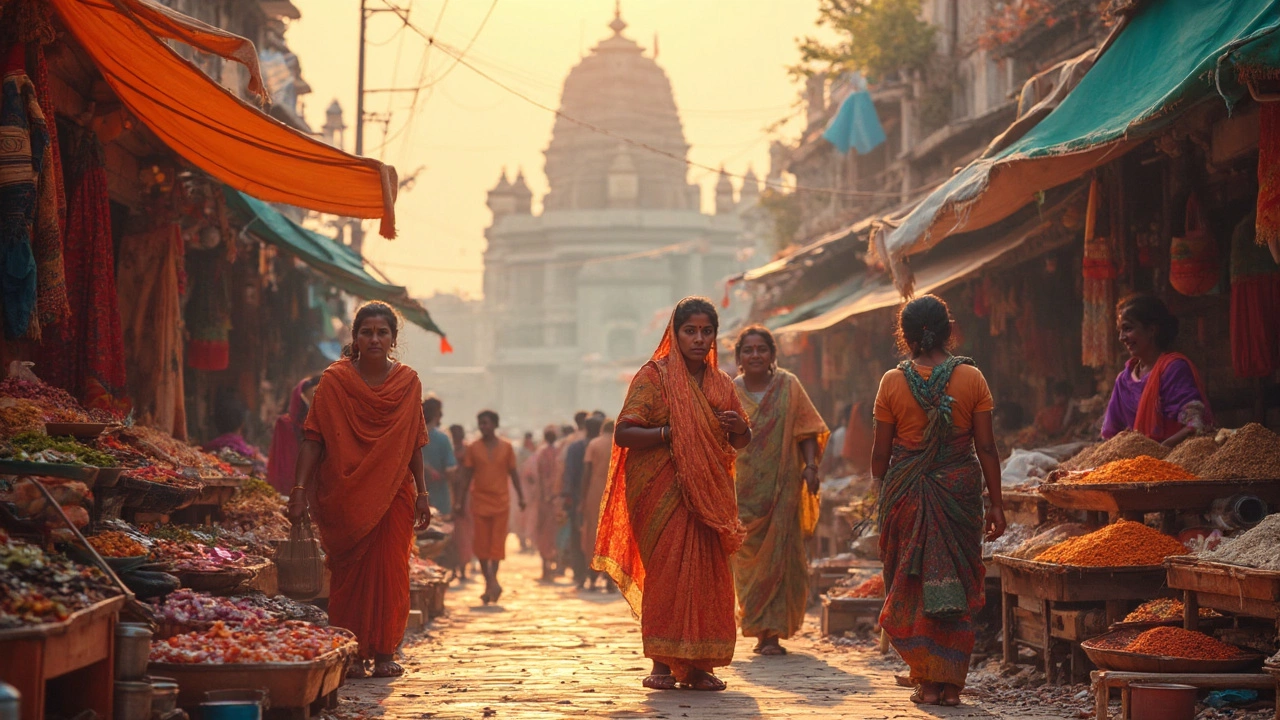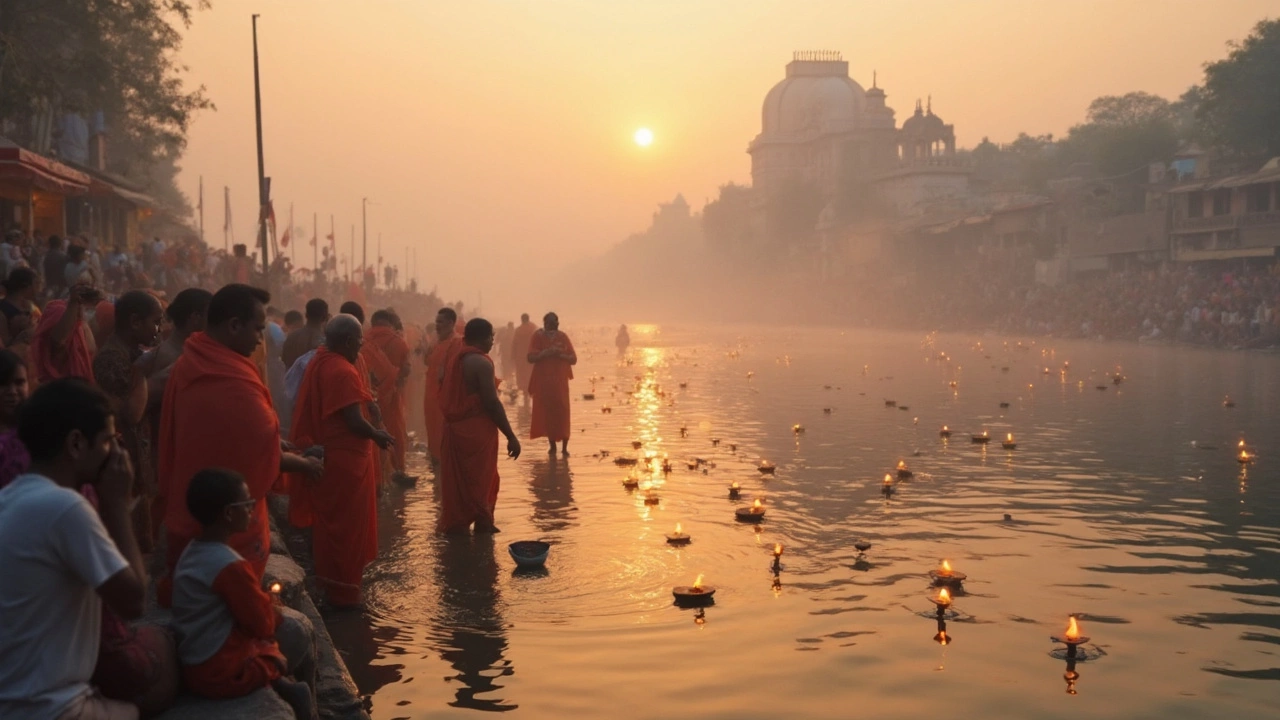India Culture: Why the World Can't Stop Talking About It
 May, 10 2025
May, 10 2025
It's almost wild how thick the culture is the moment you land in India. You can't avoid it—music blasting from wedding parades, street vendors rolling dough for snacks you've never heard of, neighbors swapping stories on stoops. All this isn’t just for show. India’s culture grabs you by the senses, and you quickly notice there’s more going on than first meets the eye.
If you want to understand why so many people rave about visiting, you’ve got to look at the little things: chai shops packed at sunrise, markets that feel like a living history lesson, and spiritual rituals that bring entire towns together. You won’t just see a monument; you’ll watch a family pray before a cricket match, or a grandmother teaching kids a dance that’s been around for centuries. That’s the kind of stuff that makes travel stories worth sharing.
- The Colorful Mix: Diversity Across States
- Food, Dance, and Daily Surprises
- Festivals: More Than Just Parties
- How to Experience Indian Culture as a Visitor
The Colorful Mix: Diversity Across States
Take a cross-country train in India and you’ll barely be in the same world every few hours. India is made up of 28 states and 8 union territories, and each place feels like its own world with its own looks, food, and even language. Seriously—people speak over 20 official languages, and more than a thousand dialects pop up in daily life. In fact, you could drive for half a day and find people eating different food, wearing different clothes, and even celebrating different holidays.
Think of Punjab up north with its loud bhangra music, hearty curries, and flashy turbans. Roll down to Kerala in the south and you’ll run into people in light cotton clothes, boat races, and spicy coconut stews. In the east, West Bengal is obsessed with fish and literary festivals, while Rajasthan’s deserts in the west are home to folk music and those famous, colorful saris.
Check this out—a look at some state-specific quirks that travelers always rave about:
- India is a patchwork of local traditions, with each state protecting its own dances, flavors, and rituals.
- Goa is known for its beach parties and Portuguese-influenced seafood.
- Gujarat’s Navratri festival runs nine nights straight with non-stop dancing and street food.
- Tamil Nadu’s temples are so old, a few were built over a thousand years ago and still have daily rituals.
- The north-eastern states celebrate eye-popping tribal festivals you won’t find anywhere else.
| State | Main Language | Famous For |
|---|---|---|
| Punjab | Punjabi | Bhangra, Butter Chicken, Golden Temple |
| Kerala | Malayalam | Backwaters, Ayurveda, Onam Festival |
| Rajasthan | Hindi | Desert Festivals, Palaces, Folk Music |
| West Bengal | Bengali | Literature, Fish Curry, Durga Puja |
| Goa | Konkani | Beaches, Seafood, Carnival |
Don’t get stuck thinking India is just about the Taj Mahal or Bollywood. It’s the daily differences from state to state that make travel there a full-on adventure. Even frequent visitors are always running into something new. You just never run out of local oddities, flavors, and dance moves to try.
Food, Dance, and Daily Surprises
Indian food isn't just spicy curry and naan. Every state has its own signature dishes, and honestly, you could eat something new every day for a year straight. Did you know India is home to over 2,000 distinct communities and each has some unique food specialty? For example, in Kolkata you’ll find sweet, syrupy rasgulla; in Punjab, thick butter chicken; in Kerala, fresh fish curry and coconut-laced stew.
Eating out in India is about much more than the food itself. Bustling street stalls serve samosas for less than a dollar, while families might gather for a home-cooked dosa feast every Sunday. Lonely Planet says it best:
"Nowhere do meals bring people together quite like in India, where every dish tells a story and every bite is a window into history."
Check out this table for just a handful of famous regional eats:
| Region | Popular Dish | Main Ingredient |
|---|---|---|
| Punjab | Butter Chicken | Chicken, tomato, cream |
| Bengal | Rasgulla | Cottage cheese balls, sugar syrup |
| Gujarat | Dhokla | Fermented rice, chickpea batter |
| Tamil Nadu | Idli Sambar | Rice cakes, lentil stew |
The rhythm of daily life is powered by more than just food. Dance shows up everywhere—from the intricate hand movements of Bharatanatyam in the south to the jumping, energetic Bhangra in the north. Folk dances aren’t just entertainment. They’re a living way of keeping stories, values, and local pride alive. If you visit in April, you’ll catch Bihu dances in Assam or, during Onam in Kerala, see women dancing in bright rings around flower carpets.
And don’t be surprised when the unexpected sneaks up on you. Kids build mini temples on the sidewalk, flower sellers decorate city corners by sunrise, and random strangers might challenge you to a game of cricket in the park. The small rituals and pop-up surprises are what make Indian culture impossible to box in.
Here are some quick tips for travelers hungry for daily discoveries:
- Try a new street food whenever you move cities—don’t worry, locals will tell you what to skip.
- Check local event calendars; cultural centers often host dance shows for free or cheap tickets.
- If you get invited to a home meal, bring sweets or fruit as a gesture—it's a big deal and the ultimate way to see family traditions in action.

Festivals: More Than Just Parties
Festivals in India aren’t just about wild colors or crazy crowds. They're social glue. Take Diwali, for example—people clean homes, swap sweets, and light up streets with lamps. Holi turns entire cities into paint-fights, but it’s really about wiping the slate clean and starting fresh with friends and neighbors. No matter what time of year you visit, there’s a good chance you’ll stumble into a celebration. Thousands happen across the country every year, sometimes for reasons that go back way farther than modern governments.
Each festival is loaded with traditions. Look at Ganesh Chaturthi in Mumbai—the city pretty much shuts down as giant statues of the elephant god ride through neighborhoods before getting dunked in the sea. In Kolkata, Durga Puja means enormous themed displays (pandals), late-night food stalls, and crowds so huge, even locals have tips on how to beat the lines. These festivals aren’t just for one religion, either. Eid has families feasting on biryani, and Christmas feels almost as sparkly, especially in Goa or Kerala.
If you want to experience a festival like a local, timing is everything. Here’s a simple cheat sheet on some big ones:
- Diwali (October/November): The "Festival of Lights," celebrated with fireworks, sweets, and lanterns across India.
- Holi (March): Famous for its colorful powders, but also includes music and street food.
- Durga Puja (September/October): Especially big in Kolkata, with parades and creative displays.
- Eid (dates change yearly): Family feasts and early morning prayers in many cities.
Some of these events attract mind-boggling crowds. Kumbh Mela—the world’s largest human gathering—saw over 50 million visitors on a single day in 2019!
| Festival | Main Location | Month | Estimated Attendees |
|---|---|---|---|
| Diwali | Nationwide | Oct/Nov | Every Indian household (over 1 billion people) |
| Holi | North India, especially Mathura/Vrindavan | March | Millions in public spaces |
| Durga Puja | Kolkata | Sep/Oct | 10+ million in Kolkata alone |
| Kumbh Mela | Varanasi, Prayagraj | Every 3 years (rotation) | 50 million (2019) |
If you're planning a trip, aligning your dates with one of these festivals adds a whole new layer to the India experience. Don’t just watch—ask to join a family puja or share sweets. That’s where you’ll find the real magic.
How to Experience Indian Culture as a Visitor
The best way to experience India is to get out there and actually do stuff, not just see it from a tour bus window. You don’t need a fancy guidebook to find culture—just a bit of curiosity and the guts to step into the unknown. Here’s what works if you want more than just a few Instagram shots.
- Eat local, not global. Start your day with masala chai at a roadside stall instead of hitting up a coffee chain. Try foods where locals eat—even tiny dhabas by the highway. India is the birthplace of over 30 types of bread, and you’ll find each state does it differently.
- Join a festival. Holi and Diwali get major headlines, but there are thousands of festivals. For example, Kerala’s Onam features massive boat races; in Rajasthan, the Pushkar Camel Fair is wild and colorful. Most towns have their own events, so ask around when you arrive.
- Shop small and chat up artisans. Handicraft markets aren’t just about buying stuff. Talk to weavers in Varanasi, potters in Pune, or block-printers in Jaipur. They’ll often explain their craft if you show genuine interest, and you’ll walk away with a story behind every purchase.
- Get invited into a home if you can. Indians love feeding guests, and home-cooked food gives you a taste of real flavors. If someone offers, say yes—just check etiquette first, like leaving your shoes at the door and washing your hands before meals.
- Try local transport. Skip taxis if possible. Rickshaws, trains, and long-distance buses take you right into daily life. Indian Railways moves 24 million people each day—the world’s biggest human conveyor belt.
And if you want to make sense of it all, don’t just rely on what you see. Dive deeper by taking a cooking class, signing up for a traditional music workshop, or joining a guided heritage walk. These get you talking to locals and picking up bits of language and logic behind certain customs.
| Tip | Why It Matters |
|---|---|
| Eat only cooked street food | Reduces risk of tummy trouble |
| Dress modestly in temples | Shows respect in religious places |
| Use your right hand for eating | Left hand is considered impolite |
| Bargain in local markets | Part of the fun and expected |
There’s no single way to "do" Indian culture, but if you stay open and skip the bubble-wrap, you’ll end up seeing sides of the country you won’t find in any guidebook.